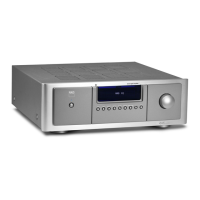> Advanced Power Supplies
The M2 uses three power supplies, all of them highly
efcient switch mode types. Each channel gets its own
high current power supply in a dual mono conguration.
The Input stage and control sections get their own
dedicated supply with multiple regulated secondary
voltages for individual sections.
> Analogue Input Section
We have provided a state-of-the-art Analogue-to-Digital
converter stage for analogue sources and for those who
still choose to use a traditional analogue preamplier.
This fully balanced stage accepts both a Single Ended
input and a Balanced XLR input. Both the analogue
input buffer amp and the ADC are of the highest quality
available today.
> Digital Soft Clipping
Digital Soft Clipping prevents the harsh sound and
potential speaker damage that can result with a severely
overdriven amplier.
> Dynamic Power
Digital PowerDrive optimizes performance when driving
real loudspeakers by maintaining optimum power
delivery and lowest possible distortion. Unlike most
digital ampliers that do not have power reserves, the
M2 has excellent dynamic power capabilities.
> Digital Processor Loop
This unique feature allows the advanced user to insert
external digital lters into the signal path. The Optical
TosLink format allows fuss-free connection to Macs
where there is a wide library of crossover lters and
room correction programs. Digital outputs in both coaxial
and optical formats allow for multiple M2s for bi- or
tri-amplication of advanced loudspeaker systems.
> Effective Control
An RS-232 serial interface is exible for home
and studio use, allowing the M2 to be controlled
from the PC or via advanced control systems like
Crestron and AMX.
Features continued
Direct Digital Explained
A true digital amplier can be thought of as a Digital-to-Analogue Converter that directly drives the loudspeaker.
This describes the M2 perfectly, except to say that the M2 actually has the same level of precision as the very best low
level DACs! This technology is far more sophisticated than the Class D analogue ampliers that are often erroneously
referred to as ‘digital’ ampliers.
This level of performance is unprecedented and is made possible by application of Direct Digital Feedback.
The idea of a closed loop digital amplier is not new, but the NAD M2 is the rst practical implementation of the concept.
Feedback Reinvented
The concept of feedback is simple yet brilliant. Compare the signal at the output of the amplier with the signal at the
input; any difference is caused by the distortion of the amplier. Now, invert that difference signal and add it to the
incoming signal and the difference signal will offset and cancel out the distortion. This is how it’s done in conventional
linear ampliers.

